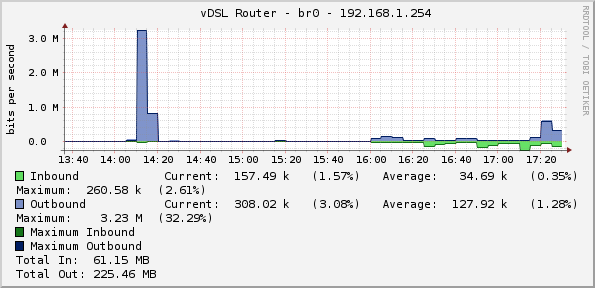
My ISP recently launched a new a new vDSL service where users can get upwards of 40Mpbs down stream, while playing around with one of the routers during testing (Billion 8200N) I noticed there was an SNMP setting, my inner geek popped out and I wanted to see what was achievable via the interface.
First thing, 10 second review.
The router is not the best vDSL one out there however it’s by far not the worst from my testing, probably the biggest thing I have against it is the price tag in comparison to the design, theres certainly more pretty competitors out there. However it does have one of the more simple web interfaces from it’s competitors.
Back to business…
Before I started wasting any time I wanted to know if the SNMP interface could be secured and made public, I don’t have a server on my LAN and I didn’t really want to add one just for some playing around, so this really was a requirement.
Public access? Yes, there is public access which is a great start
Secure? Yes, you can define the server IP address and also make the SNMP access read-only which is great for what I was doing.
Can I save my some hard work, someone might have already found the SNMP MIB’s, unfortunately I was out of luck with this. From my searching it looks like Billion change the SNMP values for each router that they launch, bit annoying but we shall prevail…
It’s probably going to be easiest just to list all of the SNMP information and see what kind of stuff is usable in there, this can be done by a fairly simple SNMP walk, example and syntax below:
snmpwalk -v 2c -c 123456 10.11.22.33 1.3.6
# snmpwalk -v {SNMP Version} -c {SNMP Password/Community} {Router Public IP address} {The MIB}
I had a good idea from my research that it was going to start with 1.3.6, however I could have just started the MIB walk at blank to see everything.
What I found out…
The billion like most home routers is just a very small version of linux, and they are actually replying to some of the standard SNMP information for linux such as interface, memory and cpu information, i suspect it would have also replied to disk information if there was one installed.
Everything else appeared to be random, here is what I found:
Upstream Speed (Attainable) - .1.3.6.1.2.1.10.97.1.1.4.0.1.21.0 Downstream Speed (Attainable) - .1.3.6.1.2.1.10.97.1.1.4.0.1.20.0 Upstream Speed (Actual) - .1.3.6.1.2.1.10.97.1.1.4.0.3.2.1.0 Downstream Speed (Actual) - .1.3.6.1.2.1.10.97.1.1.4.0.3.2.3.0 Upstream Delay - .1.3.6.1.2.1.10.97.1.1.4.0.3.4.1.0 Downstream Delay .1.3.6.1.2.1.10.97.1.1.4.0.3.4.3.0 Error Seconds over the last 15min - .1.3.6.1.2.1.10.97.1.1.4.0.16.6.2.0 Upstream SNR - .1.3.6.1.2.1.10.97.1.1.4.0.2.4.2.0
If you know of anymore please add it to the comments, thanks!
Just a couple of graphs to show what can be done, these were created using Cacti.




